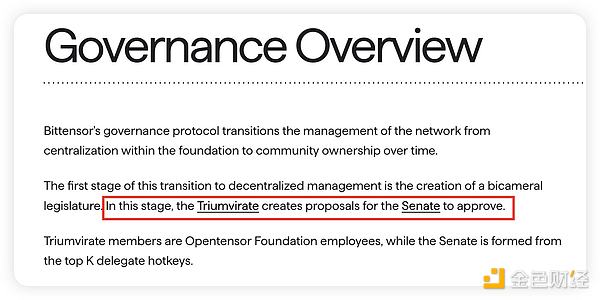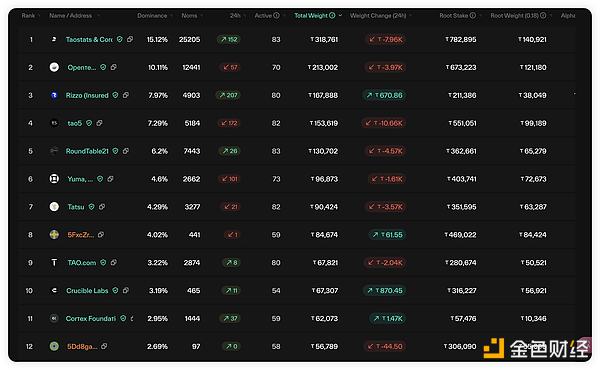Source: Twitter @0xLogicrw
First of all, although Bittensor has always officially claimed to be a "fair mining" project, in fact, the underlying Subtensor is neither a PoW public chain nor a PoS public chain; it is a stand-alone chain managed by the Opentensor Foundation (Bittensor's foundation), and the mechanism is very black box.
As for the so-called "Big Three + Senate" binary governance structure, the Big Three are three employees of the Opentensor Foundation, and the Senate is the top 12 verification nodes, all of which are their own people or stakeholders.



Secondly, the release of "Kusanagi" on January 3, 2021, marked the activation of the Bittensor network, allowing miners and validators to start receiving the first batch of TAO rewards. From the activation of the network to the launch of the subnet on October 2, 2023, these 2 years and 9 months, Bittensor has mined a total of 5.38 million TAO. But there is no document or information to explain the distribution of tokens generated from January 3, 2021 to October 2, 2023, and their final destination.
It is reasonable to speculate that this part of the tokens was divided up by internal members and interest groups, because Bittensor is not like Bitcoin, it is incubated and invested by VC.
If this part of tokens is divided by the current circulation of 8.61 million, at least 62.5% of TAO is in the hands of internal members and interest groups. In addition, Opentensor Foundation and some invested VCs also operate verification node businesses on Bittensor, so the proportion of chips in their hands will only be more than 62.5%.

Like the avalanche of OM a few days ago, all the projects whose market value you don’t know why is so high, their deformed market value is often caused by poor circulation.
Billions marketcap backed by poor liquidity.
The picture below shows the historical pledge of TAO. Don't be fooled by it and think that the pledge rate of TAO has gradually increased from low to high. The reason for this picture is that TAO is in severe inflation.
In fact, the pledge rate of TAO has never been lower than 70%, and the highest time is close to 90%. According to TAO's current market value of 2 billion US dollars, it means that at least 1.4 billion US dollars of TAO has never been involved in circulation. The actual market value of TAO is only 600 million US dollars, and the corresponding FDV is as high as 5 billion US dollars, a typical low circulation and high market value project.
The so-called AI project with the largest market value, how the bubble was blown up by the main dealer, please take a closer look.

Finally, the so-called dTAO upgrade is actually more like providing OGs with an opportunity to exit liquidity. Let you take over the TAO in the hands of the interest group in order to buy subnet tokens with high gains.
According to the three-plate theory, Bittensor's dTAO upgrade in February this year was when the "dividend plate" was unsustainable, and it had to introduce new Ponzi scheme models "splitting plate" and "mutual aid plate" to deleverage. The core purpose is to fabricate a new narrative to attract new external liquidity to continue squeezing when the old narrative is weakening and external liquidity is about to be squeezed out.
First is the "splitting": by allowing all subnets to issue tokens, TAO has successfully positioned itself as the base currency for all Bittensor subnet tokens, and its value is supported by the tokens of dozens (and more) of subnets.
Due to the poor depth of the trading pool, subnet tokens often have amazing gains. In this way, Bittensor presents to the outside world a disguised mask that the ecosystem can provide high ROI opportunities. The exaggerated nominal ROI provided by the subnet Alpha token artificially creates huge buying pressure for TAO and covers the sale of TAO by the root network verification nodes.
Unfortunately, Bittensor's closed ecosystem, coupled with the market environment from bull to bear, has resulted in the dTAO upgrade not being able to attract enough external liquidity, and even the internal liquidity (those TAOs staked on the root network) has not been sufficiently mobilized and activated.
At the same time, the lowered entry threshold of subnets and the unlimited number of tokens have led to too much and too fast issuance of tokens, diluting the overall liquidity of the Bittensor ecosystem, which is already small.
The second is "mutual assistance". Unfortunately, Bittensor's subnet coin issuance cannot establish a mutual assistance model where funds can be highly circulated like Solana's http://Pump.fun, because Bittensor's network infrastructure is very poor, and even different subnet tokens cannot be exchanged, making it difficult for participants in subnet tokens to migrate liquidity between different subnets. This further exacerbates the liquidity dilution problem caused by the high split rate, and it is impossible to keep funds in the market to continue to participate in speculation like in the past.
Once the large stakers of the root network begin to flee collectively, the liquidity on and off the market will quickly dry up.
The moment you sell, game over.

So are the big investors fleeing? The answer is "They are fleeing"!
Since the launch of dTAO:
➤ Bittensor Protocol injected 450,000 TAO into the subnet pool
➤ 150,000 TAO (33%) flowed to the root network verification node through the “automatic sell” mechanism
➤ The root network stake (τ₀) decreased by 150,000 (5.86 million → 5.71 million)
This means:
300,000 TAO (≈ US$70 million) successfully escaped from the root network and may be liquidated in CEX.


Moreover, Bittensor's basic plate was subnets and miners. Bittensor's previous model was like VC, giving money to projects to let them focus on building valuable business models first, without having to worry about how to make money to ensure a balance between income and expenditure. This is the core reason for attracting projects to build subnets on Bittensor.
The project attracted miners who provided computing power (or "intelligence" in Bittensor's words) to Bittensor. This "good for you, good for me, good for everyone" situation is the core reason why Bittensor can become the largest encrypted AI project in terms of market value.
However, after the dTAO upgrade, the interests of the subnet project parties, miners and verification nodes are no longer consistent, and the original "good for you, good for me, good for everyone" no longer exists. The dTAO model has no benefits for the subnet project parties, and the collapse of the economic model is Bittensor's biggest and most fundamental problem at present.
In Bittensor's dTAO model, the subnet Alpha token is a "warrant" we obtain by staking TAO in the subnet, and it is not a token that can be circulated in the general sense.
This makes it difficult for the subnet project parties to invent any effective Tokenomics for these tokens. These Alpha tokens are of no use to retail investors except for being able to generate more Alpha tokens.
According to my observation, the most common way for subnet project parties to increase the price of coins is to announce that they will use project revenue to buy back Alpha tokens, such as Chutes (SN64).
But if Subnet Owner can only empower Alpha tokens in this way, then funny things will happen. The 18% Alpha tokens that dTAO distributes to subnet project parties will always be in the hands of the project parties themselves. After all, if you have announced that you will use project revenue to buy back, why do you still want to sell your own tokens?
Selling and buying back are contradictory.
Therefore, not only can subnet owners not get any income from the dTAO model, they even have to subsidize it: create external income and inject it into their subnet Alpha tokens.
This means that subnet project parties and miners are essentially working for verification nodes.
As the privileged class of the Bittensor network, the verification nodes cannot do anything of value, and they can continue to sell subnet Alpha tokens from the beginning of the dTAO upgrade. The TAO flowing to the root network accounts for up to 1/3 of the daily emission.
The reason why Bittensor can attract other projects to build subnets on them is essentially because the previous TAO emission is a good subsidy mechanism for emerging projects with no income, allowing these projects to focus on the business model that needs to be run.
If this subsidy mechanism not only disappears, but even reverses, why should the subnet project party build a subnet on Bittensor?
Go it alone directly, and all the income belongs to you. Isn't this good?
Therefore, the dTAO model, as a means for interest groups to ship goods, is hurting the basic foundation of Bittensor's development to date.
Although the business models of most of the subnets in the Bittensor ecosystem are a bunch of shit, without them, Bittensor will lose its last fig leaf.
 Miyuki
Miyuki
 Miyuki
Miyuki Weiliang
Weiliang Anais
Anais Alex
Alex Miyuki
Miyuki Weiliang
Weiliang Weatherly
Weatherly Alex
Alex Alex
Alex Catherine
Catherine